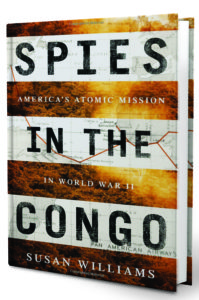
BEFORE WORLD WAR II, workers unearthed tons of uranium ore from the open-pit Shinkolobwe mine in the Belgian Congo. The substance’s purity was unparalleled anywhere else on earth. But until the discovery of nuclear fission in late 1938, there was little market for the radioactive ore. Then uranium, an essential ingredient in developing an atomic bomb, became a substance of intense interest. As war enveloped the world, the Allies and Germany alike aimed to control its supply—foremost of all, the ore from Shinkolobwe.
Thanks to the prescient Albert Einstein, the United States got the jump on obtaining a good share of the stockpiled Congolese uranium by 1942, but hundreds of tons still awaited delivery. To safeguard the secret shipments and keep the uranium out of Nazi hands, covert intelligence agents of America’s Office of Strategic Services (OSS) landed in the Congo.
This is the setup for the exhaustively researched and at times entertaining Spies in the Congo, by Susan Williams. The central figure of the book is Wilbur “Dock” Hogue, a civil engineer turned OSS station chief in the Congo. Williams describes Hogue as six-foot-three, whip smart, handsome, brave, and boasting “the most piercing eyes”; he comes straight out of central casting in the hero department. Hogue is supported and confounded by a host of fascinating individuals, including his OSS boss (a well-regarded ornithologist before the war) and one of his recruits (a retired, left-wing radical journalist acting as an illicit diamond buyer for Hogue in his investigations of smuggling routes). They inhabit a Congo that makes the nest of spies in Casablanca look mild by comparison. Hogue alone survives three attempts on his life by German assassins.
Williams has picked an epic of a subject. However, Spies of the Congo suffers from a lack of focus on driving forward a cohesive narrative. The rich cast of characters numbers too many, and one easily gets tangled in an affair of who’s who. The list of dramatis personae at the front of the book, for example, runs seven pages long. Further, the story never quite clearly sets out how—or if—Hogue ultimately made an impact in protecting the uranium supply and thwarting the Germans, particularly since the United States obtained the majority of the ore long before Hogue even arrived on the scene. Still, for those passionate about atomic history and OSS operations, Williams offers fresh, well-sourced new information and some compelling cloak-and-dagger activity, all within the arresting scene of the Congo. —Neal Bascomb is the author of the New York Times bestseller The Winter Fortress and forthcoming The Breakout Artists.





